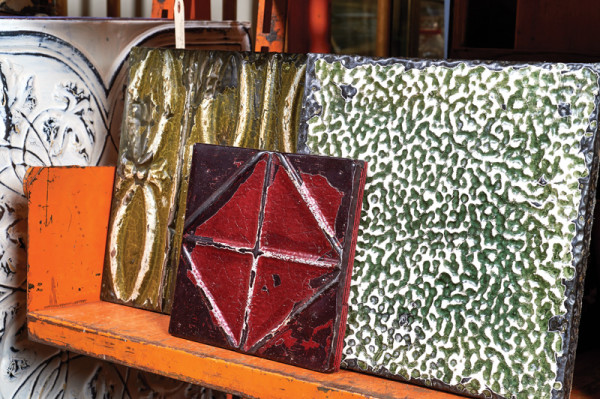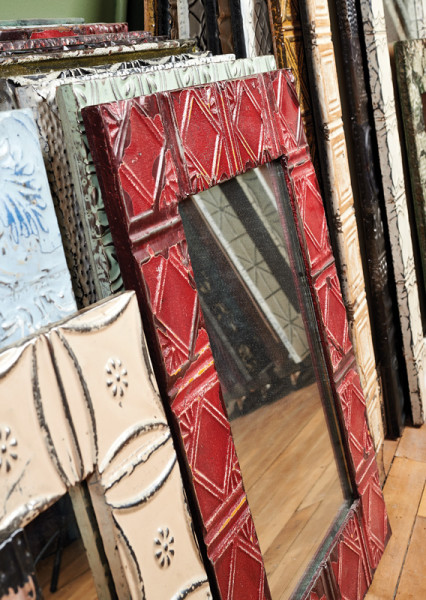
Mass-produced, embossed steel panels were first available in the U.S. during the 1880s and marketed as economical, fireproof ceilings.
Dan Mayers
The folks at Olde Good Things were stumped. This salvage company (based in Scranton, Penn., with showrooms in New York City and Los Angeles) had accumulated hundreds of vintage tin-ceiling panels. But beautiful as they were, nobody wanted them. The company repurposed the panels to create artful mirrors and picture frames. Their ornamental patterns can be appreciated up close. After a slow start, now more than 100,000 tin-framed mirrors have been sold from San Francisco to Rome.
How To Do It
1. Cleaning
The old metal panel is laid flat and cleaned with a wire brush to remove dirt and grime—but old paint and its patina are preserved. Salvagers wear work gloves (edges are sharp), eye protection, and a face mask to protect against leaded paint dust.
2. Framing
First a wood frame for the mirror is made from ¾” plywood. (Standard sizes frame mirrors 8″ x 10″ to 4′ x 8′; custom circles and other shapes and sizes are available.) The tin panel is then cut (usually 6″ wide) and laid out over the wood frame, with the pattern centered and a ¾” overlap at the edges to wrap around to the plywood back. The tin is secured with 5/8″ brad nails using a gun; the metal is carefully hammered to bend around the frame. Corners are cut and folded around the edges, like wrapping paper on a present.
3. Finishing
Generally, frames then get a light brush-coat of paint (favorites are ‘Dragonfruit Red’ and ‘Rivulet Green’ from Sherwin-Williams). When it’s dry, the frame then gets a light overspray of a medium-green paint to soften colors, so they don’t appear too new and vibrant; after drying, the metal is rubbed with steel wool to allow highlights of the pattern to show. A final coat of dull lacquer preserves the finish.
4. The mirror
Generally, the mirror thickness is ¼”; mirror glass is cut and set in a silicone bed in the frame, which secures it and also cushions the glass. The assembly gets a plywood back fitted with D-rings and six-strand wire for hanging.

Repurposed tin ceiling panels.
Dan Mayers
Tin Ceilings
Metal ceilings are a uniquely American story. Mass-produced, embossed steel panels were first available in the U.S. during the 1880s and marketed as economical, fireproof ceilings. These early metal ceilings were tin-plated to retard rusting. The stamped patterns were complex and ornate, meant to stand in for decorative European-style plasterwork ceilings (at a fraction of the cost). Later designs extended to Art Deco and Colonial Revival patterns. Easy to install and needing only minimal maintenance, they were popular across the country. “Tin ceilings” remained popular until World War I, when manufacturers’ efforts were directed elsewhere. Their current popularity dates to the Victorian Revival of the 1980s. Since then, metal ceilings have been used in commercial and residential interiors, painted or even clear-finished for a more industrial look.







